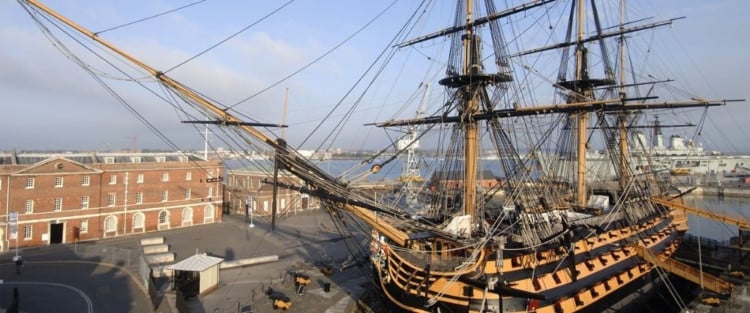A CENTURY after HMS Victory was moved into her final resting place, in Dry Dock 2 at Portsmouth Historic Dockyard, the next phase of a £35m restoration project of the iconic and historic ship is set to begin.
These major conservation works to Victory carried out by the National Museum of the Royal Navy will ensure the ship is protected for the next half century.
It comes after first-phase work saw the ship supported from below by 130 state-of-the-art props, and a visitors’ walkway created alongside the bottom of the hull.
Phase two will see rotting planking removed from the hull and replaced with new oak and repairs made to the ship’s structural framework.
She will also be fully re-rigged to complete the refurbishment costing £35m and lasting ten to 15 years.
The work will provide visitors with a once-in-a-generation opportunity to see beneath Victory’s skin and experience a First Rate Line-of-Battle ship being taken through a Great Repair.
HMS Victory was the flagship of Vice-Admiral Lord Nelson at the Battle of Trafalgar off the Spanish coast on October 21, 1805.
Under Nelson’s command, a smaller Royal Navy fleet defeated a combined French and Spanish fleet.
But during the battle Nelson, easily distinguishable in his uniform, was shot and killed.
On returning to Portsmouth, HMS Victory continued in service until she was finally moored up in Portsmouth harbour, where she slowly deteriorated.
One hundred years ago, on January 12 1922, the oldest commissioned warship in the world was in danger of sinking, so she was towed from the harbour and secured into the dry dock.
Dry Dock 2 is a scheduled ancient monument and is itself 220 years old.
Victory, launched at Chatham in 1765, was opened as a museum ship to the public by King George V on July 17, 1928, and has since welcomed more than 30 million visitors.
In 1941 she survived a 500lb bomb dropped by the German Luftwaffe during the Second World War. The blast caused severe damage to Victory’s keel.
The keel was repaired, and as well the millions of visitors, she has since welcomed a host of famous guests, including royalty, at dinners and balls.
Although a popular tourist attraction, Victory remains the flagship of the First Sea Lord & Chief of Naval Staff.
The Victory dry dock now includes the chance to view the enormous hull of the ship from a dedicated walkway, weaving through the recently-completed and new state-of-the-art support system.
It was installed after a survey found that Victory, now more than 250 years old, required a further, more comprehensive restoration.
The 3,600-tonne ship had begun to sag under her own weight, with the hull being squeezed out of shape by an inadequate system of 11 ageing steel ‘cradles’.
Additional issues, such as humidity, rot and insect infestation, made the problem worse still.
In a collaboration between the museum and BAE Systems, the cradles were replaced by more than 130 ‘smart’ props to provide better support.
The props contain technology that measures the load on them.
The results are fed into a computer-generated 3D model of the ship that simulates actual and likely loads.
The props can then be adjusted to compensate when parts of the ship, such as masts or sections of decking, are removed to either be restored or replaced.
And using the newly-installed walkway between the props, visitors can now see the Victory’s keel which, laid in 1759, is its oldest part.
For information about HMS Victory and Portsmouth Historic Dockyard and its attractions, such as the Royal Marines Museum, visit the website at https://www. historicdockyard.co.uk





Comments
This article has no comments yet. Be the first to leave a comment.